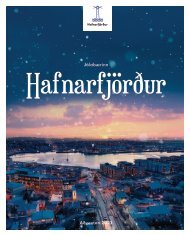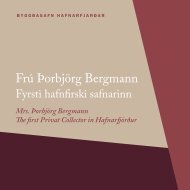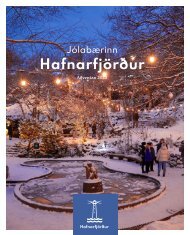Þannig byggðist bærinn
Skipulag og uppbygging Hafnarfjarðar á fyrstu árum kaupstaðarins
Skipulag og uppbygging Hafnarfjarðar á fyrstu árum kaupstaðarins
You also want an ePaper? Increase the reach of your titles
YUMPU automatically turns print PDFs into web optimized ePapers that Google loves.
THUS, THE TOWN WAS BUILT | FIRST YEARS WITH OFFICIAL MUNICIPAL STATUS
23
At the time, when Hafnarfjörður received municipal status in 1908, there was no planning of the
settlement and few proper streets within the town. It was clear that this would continue for some time,
as street construction was both costly for a small town and also the lie of the land made it very difficult.
There are travel descriptions from people who visited Hafnarfjörður in the early 20th century stating that
they were surprised at how few houses were in the town but that they had widely seen smoke emerging
from depressions in the lava field. It was an indication that there were human settlements underground.
In 1911, a committee was set up that was given the assignment to name the streets and trails and
number the houses in the market town. The report submitted by this committee said, amongst other
things:
“When travelling around Hafnarfjörður and looking
around the settlement, it becomes quickly clear that all
new road construction is subject to great difficulties,
not only because of the rugged landscape, but rather
and certainly because of how irregularly it has been
built, with no consideration from the beginning to
where roads should be built when such a time came”.
In the end, the committee members gave names to most of the streets and paths that existed in the
town, but in the areas where there was the least organisation, the areas were simply called “neighbourhoods”
and houses numbered within them. The first streets to receive names were Strandgata,
Vesturgata, Suðurgata, Nyrðri- and Syðri-Lækjargata, Mjósund, Miðsund, Gunnarssund, Merkurgata,
Selvogsgata, Jófríðarstaðavegur, Selvogsvegur, Brattagata, Brekkugata and Templarasund. The two old
street names, Kirkjuvegur and Reykjavíkurvegur, were kept. The neighbourhoods were Austurhverfi,
Miðhverfi, Vesturhverfi, Vesturhamar and Austurhamar, as well as Ásbúðarhverfi and Skuldarhverfi to the
south of the town.















